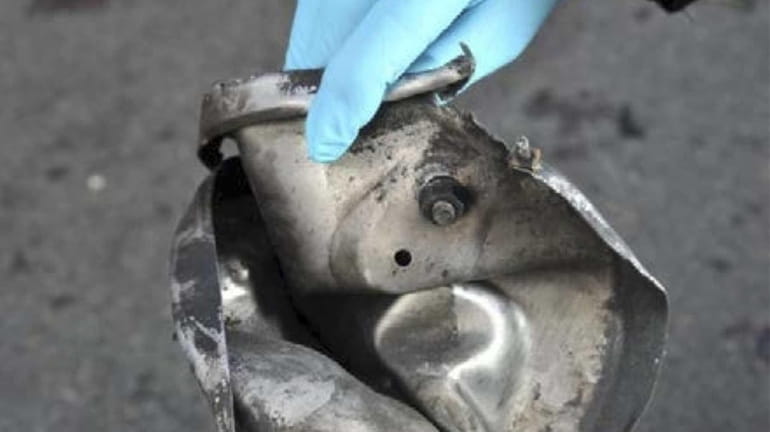Experts: Boston Marathon pressure cooker bombs similar to roadside devices

The remains of a pressure cooker that investigators say was part of one of the bombs that exploded during the Boston Marathon is shown in this image provided by the FBI. (April 16, 2013) Credit: AP
BOSTON -- The nail-packed twin bombs that killed three and injured more than 170 at Monday's marathon here resemble the household kitchen appliance retrofitted by terrorists around the world to inflict carnage on the cheap, experts say: the pressure cooker.
"Make A Bomb in the kitchen of your Mom" was the title of a 2010 how-to article in the al-Qaida online propaganda magazine -- edited by Samir Khan, an expat, later assassinated, who grew up on Long Island -- that schooled aspiring killers.
The device the article describes is similar to common roadside bombs and possibly the ones used in Boston, said a federal law enforcement official familiar with the investigation who spoke on the condition of anonymity.
But at a news conference Tuesday, the head of the Boston FBI office, Richard DesLauriers, said investigators don't know who bears blame for the attacks.
"At this time, there are no claims of responsibility," he said. "The range of suspect and motive remain wide open."
A preliminary analysis of the bombs, which went off near the race's finish line on Boylston Street, suggests they are similar to the improvised explosive devices found in war-torn regions like Iraq and Afghanistan, the law enforcement official said.
"The shrapnel, the simplicity of it -- it's something right out of the Iraq War. A basic roadside bomb," the official said.
That "basic bomb" can be seen in the design of the Boston bombs, the law enforcement official said: pressure cookers stuffed with nails, ball bearings and other projectiles, and hidden in black duffel bags left near the 26.2 mile mark in the race.
What appear to be fragments from a pressure cooker were recovered at the scene, along with BBs, nails and black-nylon fragments possibly from a bag used to house the device, the FBI said.
Black explosive powder and a circuit board believed to have been used to detonate the bombs were also found, the federal official said.
Similar explosives have been used in third-world hot spots from South Asia to the Persian Gulf, and one of the devices used in the botched bombing of Times Square in May 2010 employed a pressure cooker.
The Pakistani Taliban, which claimed blame for the 2010 Times Square attempt, said it had no role in the Boston attack, according to The Associated Press.
A 2010 bulletin issued by the Department of Homeland Security and the FBI warned pressure-cooker bombs are as easy to transport as they are to conceal.
"Terrorists can exploit the innocuous appearance of easily transportable items such as pressure cookers to conceal IED components," the alert said. "Placed carefully, such devices provide little or no indication of an impending attack."
That some victims lost limbs in the blast puts the device "into a powerful class," said John Goodpaster, head of the forensic science program at Indiana University-Purdue University, and former chemist with the federal bureau of Alcohol, Tobacco, Firearms and Explosives.
Goodpaster said the blasts appeared to be from a "high explosive of some kind, military explosive, commercial explosive or improvised explosive."
Spectator John Hess Jr. of Boston said his sister Kara lost part of her leg in the blast. "The metal just sliced through her. I'm in shock," he said. "You don't think this will happen at home."
With Anthony DeStefano
and Chau Lam
